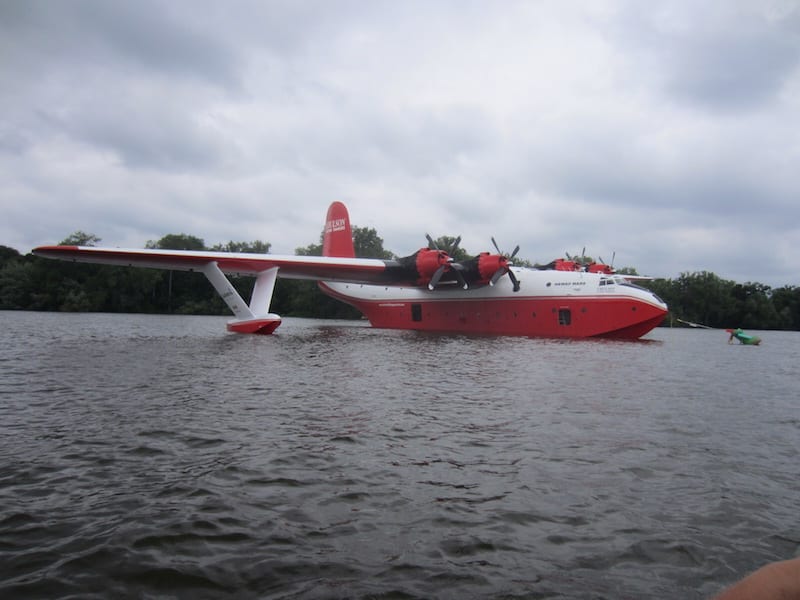
In perhaps a one-time-only visit, the huge Martin Mars water bomber from British Columbia made quite at splash at AirVenture 2016 by dropping an impressive 7,200 gallons of water on the runway to cap off several afternoon air show appearances during the week.

Martin Mars at Oshkosh 2016 (Photo by Bert Reiheld)
Owned and operated since 2007 by Coulson Flying Tankers, the “Hawaii Mars” is one of two surviving examples of the five production aircraft built for the U.S. Navy as long range maritime reconnaissance bombers by the Glenn L. Martin Aircraft Company.
After the war, the Navy used the planes with great success as transports on the San Francisco-Honolulu route until they were beached in 1956.

The Martin Mars on Lake Winnebago near the EAA Seaplane Base (Photo by Bert Reiheld)
In 1960, the four remaining Mars flying boats were saved from the scrapper by a Canadian consortium of lumber companies that had them converted to water bombers by adding water tanks in the cargo bay and two retractable pick-up scoops that can fill the tanks in 30 seconds as the plane skims along the surface at around 80 knots.
When over a fire, 22 doors open in the hull and dump the load of water all at once.
Previously unable to attend the world’s largest fly-in convention because of summertime firefighting contracts, the 70-year-old Martin Mars made the 9.4 hour non-stop flight from Vancouver Island’s Sproat Lake in western Canada, where it has been based since 1960. With headwinds, the return trip was expected to take around 12 hours at its 165 knot cruising speed.

Moored on the water (Photo by Tom Snow)
With a wingspan of 200 feet and interior space equivalent to a 14-room house, the Martin Mars is the largest flying boat ever flown operationally. In cruise configuration, the four 2,500-horsepower Wright R3350-18 radial engines burn around 430 gallons per hour, which increases to 780 gph when fighting fires.
Aviation enthusiast Kermit Weeks reportedly offered to buy the fuel necessary for the thirsty flying fire truck to attend the show and he accompanied the crew on the flight from Western Canada to Oshkosh.
After landing on Lake Winnebago, the plane moored to a newly-installed 12,000 pound concrete anchor near the Experimental Aircraft Association’s Seaplane Base. Adding to the challenge of bringing the Hawaii Mars to Oshkosh is that it does not have wheels and can only land on water. Therefore, a large ground support team also made the trip, including a NASCAR-type shop trailer with spare parts, plus a fuel tanker, a crew bus and a trailer carrying a motor launch.

Crowds gathered to see the giant flying boat. (Photo by Tom Snow)
The plane drew a larger-than-normal number of spectators to the seaplane base to see it at anchor and to watch water takeoffs and landings. The crowd was also treated to low-level fly-bys and a water drop after each air show appearance. Thirty-minute tours of the flying boat, priced at $125 per person, quickly sold out.
A Monday night appearance at the Theatre in the Woods by the owner and crew of the Hawaii Mars provided insight into the unique business of aerial firefighting with an antique warbird.
The Hawaii Mars and its sister ship, the Philippine Mars, which has not flown in several years, spent almost 50 years protecting the valuable forests near its Vancouver Island base, but the Coulson Company took a different approach after its 2007 purchase by marketing its services to California and Mexico, in addition to Canada.
“There will never be another aircraft that can kill a wildfire like the Mars,” said Wayne Coulson, CEO of Coulson Flying Tankers.
Despite investing a reported $4 million in upgrades to Hawaii Mars, including Garmin 600 avionics with synthetic vision for flying with limited visibility, the plane has not stayed busy for several fire seasons. To try to generate revenue, Coulson now offers a $25,000 two-day “Ultimate Flying Experience” to pilots who want to fly the plane from the left seat.
Although marketing resulted in firefighting contracts in California and a 20-day stint in Mexico that was documented in a “Mighty Planes” feature on TV, the water bomber has been “unemployed” recently due to several circumstances, including its age and strong competition from newer turbine and jet-powered water bombers.
Now, with their firefighting days probably over, the two Mars flying boats are for sale or trade. Of course, the appearance at Oshkosh was good exposure for the Hawaii Mars, which is being offered on the open market.
Meanwhile, the Philippine Mars, which has been beached on the shore of Sproat Lake for several years, has been repainted in its original Navy colors and a trade may be in the works to the National Naval Aviation Museum in Pensacola.

A mechanic works on the Martin Mars during Oshkosh. (Photo by Tom Snow)
In an unfortunate conclusion to its week at AirVenture, the Hawaii Mars struck submerged rocks in Lake Winnebago after an engine warning light caused its pilots to abort a takeoff with a full 70,000-pound load of water on board.
Several holes were punched in the hull as the plane taxied back to the seaplane base at the shallow lake. Divers were able to make temporary repairs to the hull prior to the plane’s flight home, where permanent repairs will be performed.
Source: http://generalaviationnews.comMartin Mars makes a big splash at Oshkosh